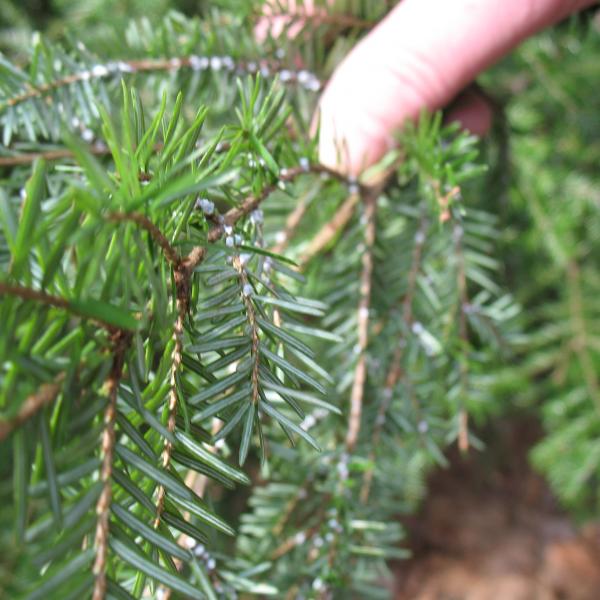
As the 2015-2016 hemlock woolly adelgid survey season got under way there was some concern for the condition of hemlock trees in southern Vermont. The preceding growing season included a period of sinificant drought. Trees on ledgy sites were showing signs of stress. Elongate hemlock scale had been found in the area, sometimes coexisting with HWA. As the winter wore on, temperatures were mild, indeed new high temperature records were established. The general consensus was that adelgids should survive quite well and the threat to hemlocks would increase.
The annual HWA winter mortality study was conducted recently by the Department of Forests, Parks and Recreation (FPR). The results were a bit of a surprise, though they seem to match results from other northeastern states. Many parts of the region seem to be experiencing high winter mortality rates. The four Vermont sites have rates ranging from 93.8 to 99.0 percent.
With many of the adelgids dying, hemlock trees will be a little less stressed than they would have been otherwise. This is now the third winter in a row that winter mortality rates have been in this range. While the trees get a little break, they are not "out of the woods" yet. Populations of adelgid will rebound. With two generations per year, the sisten and progredien - each reproducing asexually - the population can grow quickly. If just one adelgid survives the winter, its "grandchildren" can number as many as 30,000 by the following winter.
FPR has been monitoring population density and recovery for several years. The data is being collected and analyzed by Virginia Tech as part of a large project - the HWA Initiative. Each winter FPR staff mark infested branches and count the number of sisten ovisacs. The following summer the same branches are re-inspected to determine the number of progredien generation adelgid. This can give a sense of how well the population recovered from the winter. Students from the Mountain Campus of Burr and Burton Academy have assisted with this density study for the last several winters.
Lab tests done by scientists at UVM have established that lethal temperatures are somewhere in the 22 begrees below zero range. Theories for why the mortality rate was so high in a mild winter abound. It is always good in these discussions to remember that there is always variability in nature. So, the timing of cold exposure is important. Other important variables seem to include the magnitude and rate of temperature fluctuations. This winter winter certainly had many large temperature swings.
Whatever the reason the high mortality rates are good news for hemlock trees. Fewer adelgids means less damage, less stress and a longer life than hemlocks in the south. We still don't know if our Vermont trees will eventually succomb; we just don't yet have enough experience with the infestation, but our trees seem to survive longer.
Another positive is that our mortality rates exceed the threshold needed to halt the infestation's spread. It seems that, when mortality is greater than 91 or 92 percent, HWA infestations don't spread. This seems to be the case in Vermont. There have not been many new discoveries in the last couple years. This season's survey work is not quite complete, but so far no new towns have been reported as infested.
It is not likely that we will eradicate hemlock woolly adelgid. But, the combinations of trees surviving longer and spread slowing gives researchers time to find new approaches to HWA management. Work continues to find naturally resistant trees, insect predators, silvicultural treatments, fungal bio-treatments, and appropriate chemical treatments. An integrated pest management approach - along with cold winters in the future - may help us to keep at least some level of hemlock trees in our Vermont forests.
Article by Jim Esden, VT Forests, Parks and Recreation
Photo courtesy of Vermont Urban and Community Forestry Team